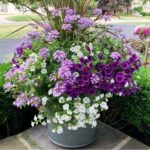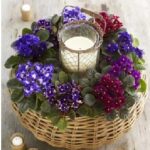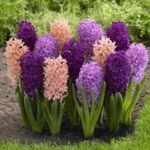Purple flowers bring a touch of elegance and mystery to any garden or indoor space. When planted in containers, these blooms can transform patios, balconies, and entryways into vibrant, inviting areas. The versatility of container gardening allows you to experiment with different plant combinations and arrangements. Here’s a comprehensive guide to creating stunning containers with purple flowers, ensuring they thrive and enhance your outdoor or indoor space.
Choosing the Right Container
- Material: Containers come in various materials like terracotta, ceramic, plastic, and metal. Each has its benefits:
- Terracotta: Porous and allows roots to breathe but can dry out quickly.
- Ceramic: Glazed ceramics retain moisture well but can be heavy.
- Plastic: Lightweight and retains moisture but may not be as aesthetically pleasing.
- Metal: Durable and stylish but can overheat in direct sunlight.
- Size: Ensure the container is large enough to accommodate the root system of your plants. A depth of at least 12 inches is ideal for most flowering plants.
- Drainage: Good drainage is crucial. Choose containers with drainage holes or add a layer of gravel at the bottom to prevent waterlogging.
Selecting Purple Flowers
- Petunias: Available in various shades of purple, petunias are a favorite for containers due to their long blooming period and easy care.
- Lavender: Known for its fragrance and delicate purple blooms, lavender thrives in well-drained soil and sunny spots.
- Pansies: These charming flowers offer vibrant purple hues and thrive in cooler temperatures, making them perfect for spring and fall.
- Verbena: Ideal for hanging baskets and window boxes, verbena produces clusters of small purple flowers and requires minimal maintenance.
- Salvia: With its tall spikes of purple flowers, salvia adds height and drama to containers and attracts pollinators like bees and butterflies.
- Fuchsia: These pendulous flowers with rich purple and magenta tones are perfect for shaded areas and hanging baskets.
Planting and Care
- Soil: Use high-quality potting soil that retains moisture yet drains well. Consider adding compost or a slow-release fertilizer to provide nutrients.
- Planting: When planting, ensure the root balls are at the same level as they were in their original pots. Avoid overcrowding to allow for proper air circulation and growth.
- Watering: Consistent watering is key. Most purple flowering plants prefer moist but not waterlogged soil. Water when the top inch of soil feels dry to the touch.
- Fertilizing: Feed your plants with a balanced liquid fertilizer every 2-4 weeks during the growing season to promote healthy blooms.
Designing Your Container Garden
- Thriller, Filler, Spiller: Use this design principle for a balanced look:
- Thriller: Tall, eye-catching plants like salvia or lavender serve as the focal point.
- Filler: Medium-height plants like pansies or verbena fill in the gaps.
- Spiller: Trailing plants like fuchsia or creeping thyme cascade over the edges.
- Color Combinations: Purple pairs beautifully with various colors. Consider combinations with white (e.g., white petunias), yellow (e.g., marigolds), or pink (e.g., geraniums) to create a vibrant and harmonious display.
- Texture and Foliage: Incorporate plants with interesting foliage, such as silver-leaved dusty miller or variegated ivy, to add texture and contrast.
Seasonal Considerations
- Spring and Summer: Most purple flowers thrive during these seasons. Ensure they receive adequate sunlight and regular watering.
- Fall: Some purple flowers like pansies are perfect for fall containers. Transition your summer plants with cool-season varieties.
- Winter: Move containers indoors or provide frost protection for perennials. Consider using hardy plants like ornamental cabbages with purple tones for winter interest.
Troubleshooting Common Issues
- Pests: Watch for aphids, spider mites, and whiteflies. Use insecticidal soap or neem oil to treat infestations.
- Diseases: Ensure proper spacing and air circulation to prevent fungal diseases. Remove any affected leaves promptly.
- Watering Problems: Overwatering can lead to root rot, while underwatering can cause wilting. Maintain a balanced watering routine.
 Flower Love
Flower Love



















